
Charles Hoy Fort was an American writer and researcher who specialized in anomalous phenomena. The terms "Fortean" and "Forteana" are sometimes used to characterize various such phenomena. Fort's books sold well and are still in print. His work continues to inspire admirers, who refer to themselves as "Forteans", and has influenced some aspects of science fiction.
Majestic 12, also known as Majic-12, and MJ-12 for short, is a purported organization that appears in UFO conspiracy theories. The organization is claimed to be the code name of an alleged secret committee of scientists, military leaders, and government officials, formed in 1947 by an executive order by U.S. President Harry S. Truman to facilitate recovery and investigation of alien spacecraft. The concept originated in a series of supposedly leaked secret government documents first circulated by ufologists in 1984. Upon examination, the Federal Bureau of Investigation (FBI) declared the documents to be "completely bogus", and many ufologists consider them to be an elaborate hoax. Majestic 12 remains popular among some UFO conspiracy theorists and the concept has appeared in popular culture including television, film and literature.

Raymond Alfred Palmer was an American author and magazine editor. Influential in the first wave of science fiction fandom, his first fiction stories were published in 1935.
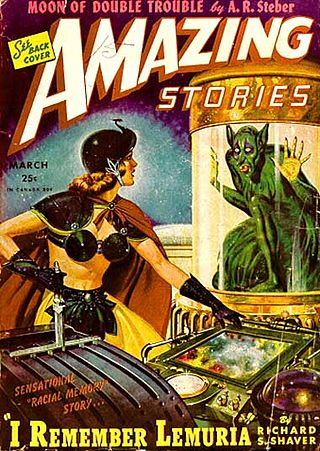
Richard Sharpe Shaver was an American writer and artist who achieved notoriety in the years following World War II as the author of controversial stories that were printed in science fiction magazines. In Shaver's story, he claimed that he had had personal experience of a sinister ancient civilization that harbored fantastic technology in caverns under the earth. The controversy stemmed from the claim by Shaver, and his editor and publisher Ray Palmer, that Shaver's writings, while presented in the guise of fiction, were fundamentally true. Shaver's stories were promoted by Ray Palmer as "The Shaver Mystery".
Dulce Base is the subject of a conspiracy theory claiming that a jointly-operated human and alien underground facility exists under Archuleta Mesa on the Colorado–New Mexico border near the town of Dulce, New Mexico, in the United States. Claims of alien activity there first arose from Albuquerque businessman Paul Bennewitz.
Kenneth Albert Arnold was an American aviator, businessman, and politician.
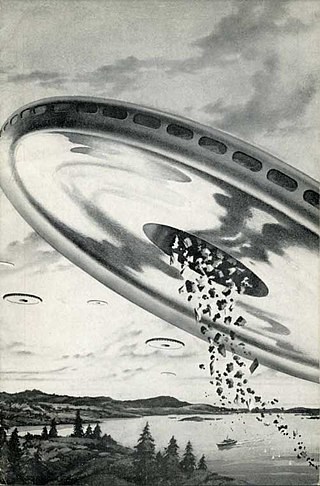
The "Maury Island incident" refers to claims made by Fred Crisman and Harold Dahl of falling debris and threats by men in black following sightings of unidentified flying objects in the sky over Maury Island in Puget Sound. The pair would later claim the events had occurred on June 21, 1947.
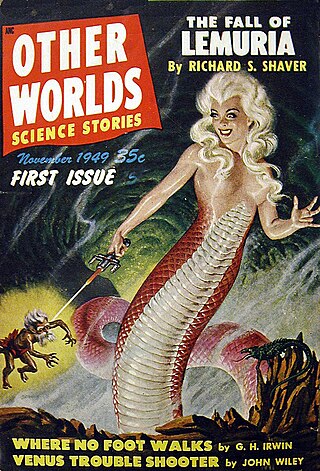
Other Worlds, Universe Science Fiction, and Science Stories were three related US magazines edited by Raymond A. Palmer. Other Worlds was launched in November 1949 by Palmer's Clark Publications and lasted for four years in its first run, with well-received stories such as "Enchanted Village" by A. E. van Vogt and "Way in the Middle of the Air", one of Ray Bradbury's "Martian Chronicle" stories. Since Palmer was both publisher and editor, he was free to follow his own editorial policy, and presented a wide array of science fiction.
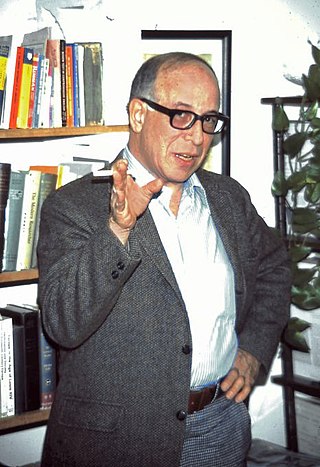
Philip Julian Klass was a preeminent American aviation/aerospace journalist and UFO researcher, best known for his skepticism regarding UFOs. In the ufological and skeptical communities, Klass inspires polarized appraisals. He has been called the "Sherlock Holmes of UFOlogy". Klass demonstrated "the crusader's zeal for what seems 'right,' regardless of whether it brings popular acclaim," a trait he claimed his father instilled in him. "I've found," said Klass, "that roughly 97, 98 percent of the people who report seeing UFOs are fundamentally intelligent, honest people who have seen something—usually at night, in darkness—that is unfamiliar, that they cannot explain." The rest, he said, were frauds.

The Center for UFO Studies (CUFOS) is a privately funded UFO research group. The group was founded in 1973 by J. Allen Hynek, who at the time was chair of the Department of Astronomy at Northwestern University in Illinois.
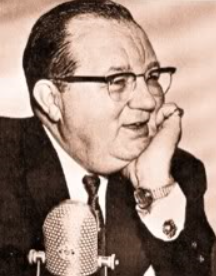
Frank Allyn Edwards was an American writer and broadcaster, and one of the pioneers in radio. He hosted a radio show broadcast across the United States in the 1940s and 1950s. Late in his life, he became additionally well known for a series of popular books about UFOs and other paranormal phenomena.
Jerome Clark is an American writer, specializing in unidentified flying objects and other paranormal subjects. He has appeared on ABC News Special Report, Unsolved Mysteries, Sightings and the A&E Network discussing UFOs and other oddities. Clark is also a country and folk music songwriter of note.
Donald Michael Kraig was an American occult author and practitioner of ceremonial magic. Kraig published six books, including his 1988 introduction to ceremonial magic, Modern Magick. He was also an editor for Fate Magazine and for his main publisher Llewellyn Worldwide.
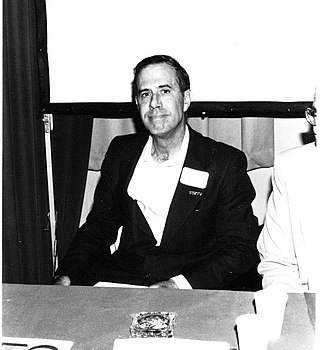
James Willett Moseley was an American observer, author, and commentator on the subject of unidentified flying objects (UFOs). Over his nearly sixty-year career, he exposed UFO hoaxes and engineered hoaxes of his own. He was best known as the publisher of the UFO newsletters Saucer News and its successor Saucer Smear, which became the longest continuously published UFO journal in the world.

Gray Barker was an American writer best known for his books about UFOs and other paranormal phenomena. His 1956 book They Knew Too Much About Flying Saucers introduced the notion of the Men in Black to ufology. Recent evidence indicates that he was skeptical of most UFO claims, and mainly wrote about the paranormal for financial gain. He sometimes participated in hoaxes to deceive more serious UFO investigators.
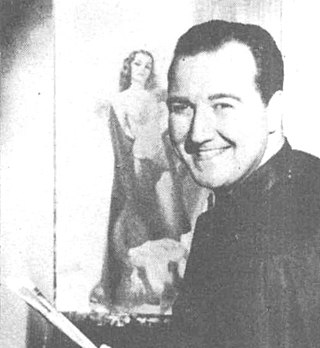
Harold William McCauley was an illustrator of pulp magazines in the science fiction field.

Beatrice Mahaffey (1928–1987) was an American science fiction fan and editor. She met Raymond Palmer in 1949 at the World Science Fiction Convention in Cleveland, and was hired to assist him at Clark Publications, his publishing company. She worked on Other Worlds from May 1950; Palmer was incapacitated by an accident for a while shortly after she was hired, though he remained involved from his hospital bed. She was listed as coeditor from November 1952 to July 1953 and from May 1955 to November 1955. She coedited both Science Stories and Universe Science Fiction with Palmer, along with the first four issues of Mystic Magazine, from November 1953 to May 1954. Science fiction historians Mike Ashley and E.F. Casebeer both consider that she had a strong positive influence on the magazines, and was probably responsible for acquiring much of the better material Palmer published. After Palmer closed his offices in Evanston, Illinois in 1955, Mahaffey continued to work on the magazine by mail from Cincinnati. In 1956, an unexpected tax bill forced Palmer to lay off Mahaffey, and he ran the magazine by himself from that point on.
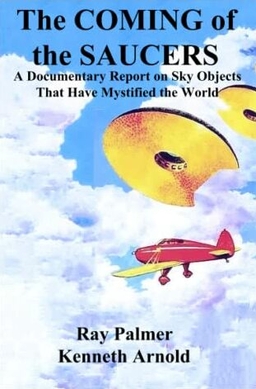
The Coming of the Saucers is a 1952 book by original 'flying saucer' witness Kenneth Arnold and pulp magazine publisher Raymond Palmer. The book reprints and expands early articles the two had published in Palmer's Fate magazine. The work blends first-person accounts attributed to Arnold with third-person summations of UFO reports.
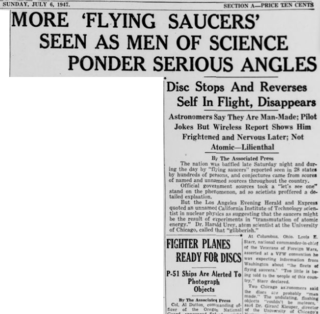
The Rhodes UFO photos, sometimes called the shoe-heel UFO photos, are two photos that were reportedly taken on July 7, 1947 by amateur astronomer and inventor William Albert Rhodes. The photographs purport to show a disc-like object flying above Phoenix, Arizona. Rhodes's account and photographs were published by the Arizona Republic on July 9.















